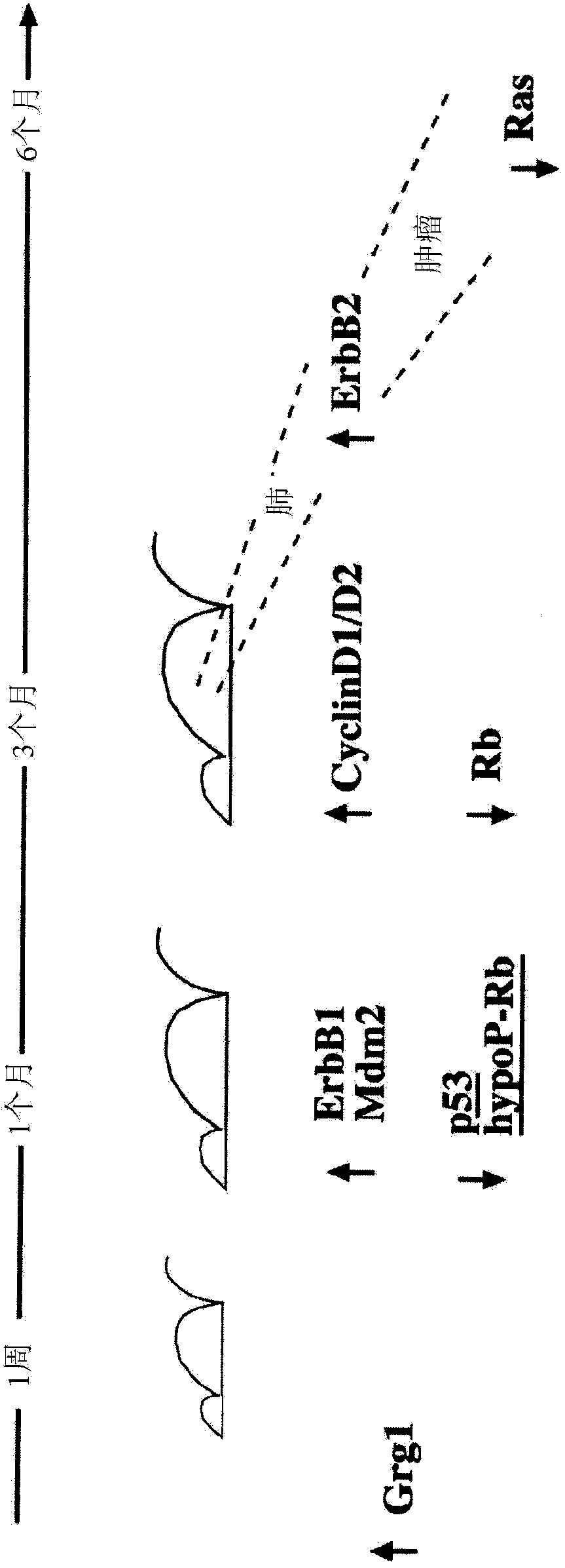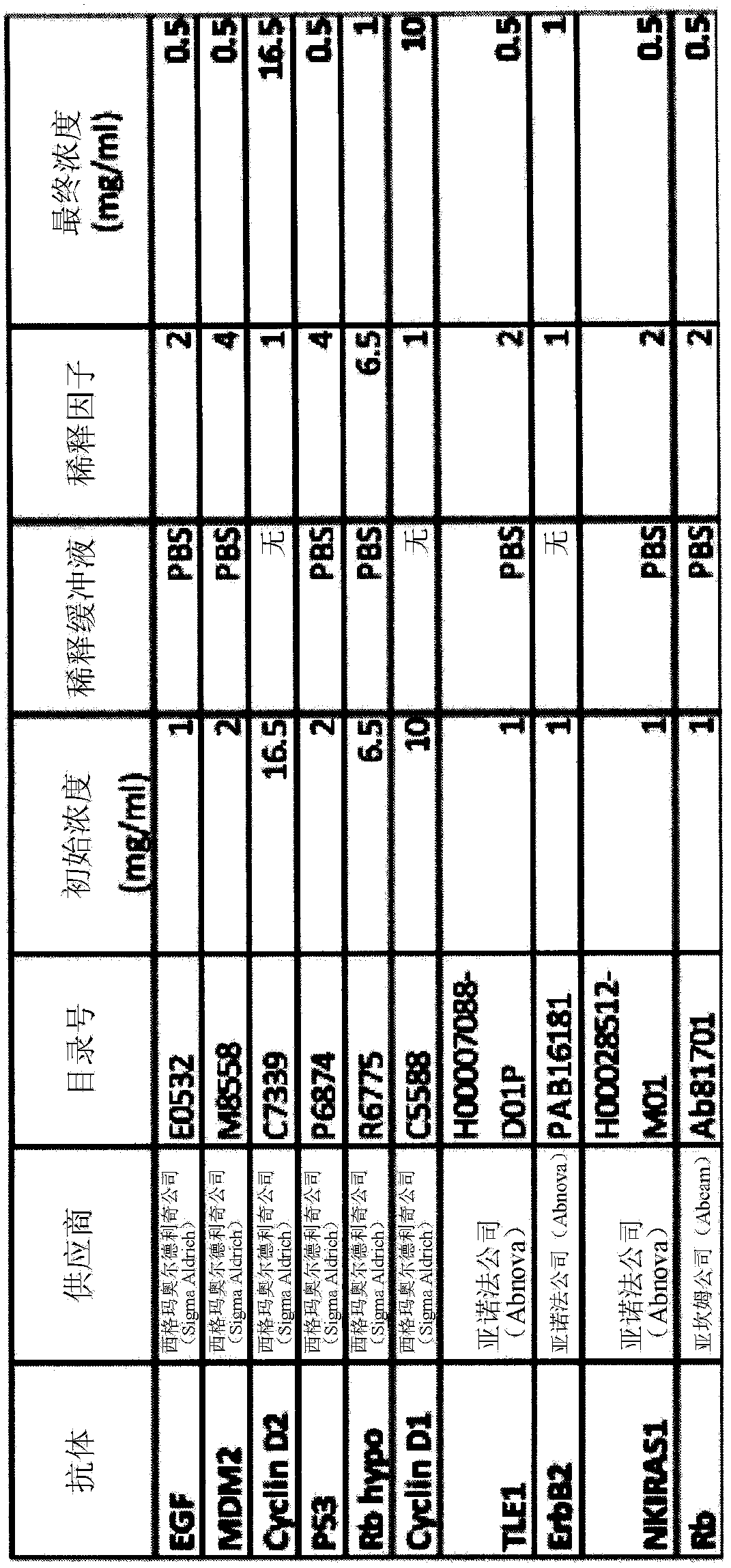Cancer diagnosis and treatment
A cancer, lung cancer technology, applied in the field of diagnosing cancer and treating cancer, which can solve problems such as unsatisfactory resolution of cancer markers
- Summary
- Abstract
- Description
- Claims
- Application Information
AI Technical Summary
Problems solved by technology
Method used
Image
Examples
example 1
[0112] Antibody Microarray
[0113] Candidate biomarkers for non-small cell lung cancer were identified in Grg1 transgenic mice, wherein protein levels were measured in Grg1 expressing mice developing lung tumors using Western blotting compared to mice without tumors. Proteins identified as altered in Grg1 transgenic mice are shown in figure 1 middle.
[0114] The purpose of the antibody microarray experiment was to evaluate the relative abundance of 10 human proteins in lung cancer relative to control samples using a commonly used antibody array for 30 human sera.
[0115] Spotting Protocol and Slide Incubation
[0116] 1. Glass Spotting
[0117] Spotting was performed with a Microgrid II spotter with a Quill Pins Microspot2500. The spot diameter is 150 μm. The spotter was equipped with a temperature-controlled Biobank set at 4°C.
[0118] The slides used were nitrocellulose slides (Gentel PATH PLUS protein microarray slides).
[0119] Antibodies were spotted on 14 pa...
example 2
[0163] medical treatement
[0164] Biomarkers can be used to predict the effectiveness of drug treatments. Grg1 transgenic mice overexpress the Grg1 (human TLE1) protein, which interacts with the HDAC complex for its function. Thus, lung tumors in Grg1 transgenic mice can be inhibited by treatment with HDAC inhibitors. HDAC inhibitor drugs are used to treat a variety of cancers, but it is unclear which patients will respond. In addition, HDAC inhibitors have severe side effects, so HDAC inhibitors with greater specific activity are being developed. For efficacy against non-small cell lung cancer, the Grg1 mouse model provides an ideal setting to test new HDAC inhibitors.
[0165] Trichostatin A (TSA) is a histone deacetylase inhibitor that inhibits the proliferation of lung cancer cell lines. However, the effect of TSA on the development of lung cancer in animal models has not been investigated. In this example, TSA was used to treat transgenic mice that developed broncho...
example 3
[0174] Groucho protein could be used to treat tumors
[0175] Considering the antagonistic effect of Grg protein on β-catenin / Tcf function, Grg protein may exert a tumor suppressor effect on malignancies caused by abnormal Wnt / β-catenin signaling. However, the lung tumor phenotype of Grg1 contradicts this hypothesis. To further address this question, Grg1 and Grg5 overexpressing mice were compared with APC-bearing min Allelic mouse crosses. APC min / + Mice carry a truncation mutation in codon 850 of one copy of the murine APC gene. Loss of the wild-type APC allele resulted in elevated β-catenin levels and the formation of intestinal adenomas in these mice. We found that Grg1 overexpression in APC min / + The model had a significant effect on the development of intestinal polyps. In contrast, APC min The presence of the allele also had an effect on Grg1-induced lung adenomas.
[0176] Grg1 reduces APC min / - Number of macroadenomas in mice
[0177] On a C57BL / 6J backgroun...
PUM
 Login to View More
Login to View More Abstract
Description
Claims
Application Information
 Login to View More
Login to View More - R&D
- Intellectual Property
- Life Sciences
- Materials
- Tech Scout
- Unparalleled Data Quality
- Higher Quality Content
- 60% Fewer Hallucinations
Browse by: Latest US Patents, China's latest patents, Technical Efficacy Thesaurus, Application Domain, Technology Topic, Popular Technical Reports.
© 2025 PatSnap. All rights reserved.Legal|Privacy policy|Modern Slavery Act Transparency Statement|Sitemap|About US| Contact US: help@patsnap.com



